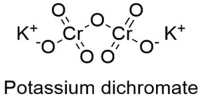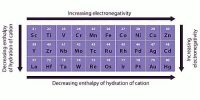Mendeleev’s periodic law states that “The physical and chemical properties of elements and their compounds are periodic functions of their atomic mass.”
Mendeleev arranged 63 elements in a periodic table according to increasing atomic weights. He showed that after every period properties of an element is repeated. This is known as Mendeleev’s periodic table. Elements having similar properties are placed in a column, known as the group and other elements are placed horizontally to each other according to their atomic weights. The horizontal rows are called periods. Mendeleev’s periodic table contained 8 groups and 12 periods.
Usefulness of Mendeleev’s periodic table is given below:
- The systematic study of elements: Mendeleev’s periodic table simplified the study of the chemistry of elements. By knowing the properties of one element in a group, the properties of other elements in the group can be easily guessed. Thus, it became very useful in studying and remembering the properties of a large number of elements.
- Correction of atomic masses: Mendeleev’s Periodic table helped in correcting the atomic masses of some elements based on their position in the table. For example, the atomic mass of beryllium was corrected from 13.5 to 9. Similarly, with the help of this table, atomic masses of indium, gold, platinum etc were corrected.
- Prediction of new elements: At the time of Mendeleev, only 56 elements were known. While arranging these elements, he left some gaps. These gaps represented the undiscovered elements. Mendeleev predicted the properties of these elements on the basis of their position. For example, he predicted the properties of scandium, gallium and germanium which were discovered later. The prediction made by Mendeleev was found to be exactly precise.
In spite of many advantages, the Mendeleev’s Periodic Table had certain deflects also. Some of these defects are given below:
- The position of Hydrogen: Hydrogen is placed in group 1. However, it resembles the elements of group 1 (alkali metals) as well as the elements of group VII A (halogens). Therefore, the position of hydrogen in the periodic table is not correctly defined.
- Anomalous Pairs: In certain pairs of elements, the increasing order of atomic masses was not obeyed. In these cases, Mendeleev placed elements according to similarities in their properties and not in increasing order of their atomic masses. For example, cobalt Co, (atomic mass 58.93) is placed before nickel, Ni (atomic mass 58.6) and tellurium Te, (atomic mass 27.6) is placed before iodine I, (atomic mass 126.9). These properties were not justified.
- Positions of isotopes: Isotopes are the atoms of the same element having different atomic masses but the same atomic number. Therefore, according to Mendeleev’s classification, these elements should be placed at different places depending upon their atomic masses. For example, isotopes of hydrogen with atomic masses 1, 2 and 3 should be placed at three However, isotopes have not being given separate places in the periodic table.
- Some similar elements are separated and dissimilar elements are grouped together: In the Mendeleev’s Periodic table, some similar elements were placed in different groups while some dissimilar elements had been grouped together. For example, copper and mercury resembled in their properties but they had not been placed in different groups. At the same time elements of group IA such as Li, Na and K were grouped with copper, silver and gold though their properties are quite different.
- Cause of Periodicity: Mendeleev did not explain the cause of periodicity among the
- The position of Lanthanides and Actinides: The fourteen elements following lanthanum (known as lanthanides, from atomic no. 58-71) and the fourteen elements following actinium (known as actinides, from atomic no. 90-103) have not been given separate places in Mendeleev’s table.














